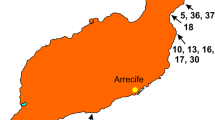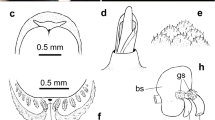Abstract
The marine sea slug heterobranch fauna from Thailand is composed of a total of 240 species, and Armina semperi is the only representative of the genus Armina recorded in the country. This species, described in the Philippines in the nineteenth century, has an uneasy taxonomic history and appears to be part of a complex of morphologically similar species, which has made its real identity difficult to determine. Comparison of samples of the genus Armina from Thailand with the original description of A. semperi showed that they were different. Furthermore, additional sampling allowed the discovery of a second species of the genus, similar to the so-called A. semperi and living in sympatry with it. In this paper, the taxonomic history of A. semperi is summarized and both species from Thailand are described as new to science. Armina scotti n. sp. is characterized by its black dorsum with pale yellowish notal ridges, widened forming three rounded blotches, not divergent posteriorly, not bifurcated; oral veil white, with a pale blue submarginal band and yellow edge; white rhinophores with a black subterminal band, which is pale blue on the inner-front sides, orange tips, and a black stripe running to the sides of the oral veil. The cutting edge of the jaws with up to four rows of denticles; radular formula 28 x 20.1.1.1.20; rachidian tooth with 5–6 strong denticles on each side of the median cusp; lateral teeth denticulate to smooth. Hermaphrodite duct very thin. Ampulla very long and wide; bursa copulatrix absent; prostate not differentiated; and penis proportionally very large and unarmed. Armina occulta n. sp. is characterized by its black dorsum with white notum narrowed forming two transverse dark bands, divergent and bifurcated posteriorly; orange mantle edge; black foot with a thick marginal band of deep blue; rhinophores deep blue with yellow tips, and a black subterminal band. The radular formula is 50 x 29.1.1.29; broad rachidian teeth, bearing 4–6 strong denticles only on the left side of the median cusp; a very thin hermaphrodite duct; very long and wide ampulla; undifferentiated prostate; large bursa copulatrix; and a penis bearing a stylet.




Similar content being viewed by others
References
Akaike H (1974) A new look at the statistical model identification. IEEE Trans Autom Control 19:716–723
Baba K (1949) Opisthobranchia of Sagami Bay collected by His Majesty The Emperor of Japan. Iwanami Shoten, Tokyo. 194 pp., 50 pls
Baba K (1955) Opisthobranchia of Sagami Bay supplement. Iwanami Shoten, Tokyo. 59 pp., 20 pls
Bergh LSR (1861) Om Forekomsten af Neldefiim hos Mollusker. Videnskabelige Meddelelser fra Dansk naturhistorisk Forening 1860:309–331. plate 8
Bergh LSR (1866) Bidrag til en Monographi af Phyllidierne, en Familie af de gastraeopode Mollusker. Naturhistorisk Tidsskrift, 3 die Række, 4:1–80, 207–380, plates 1–9
Bergh LSR (1873) Malacologische Untersuchungen. In: Reisen im Archipel der Philippinen von Dr. Carl Gottfried Semper. Zweiter Theil. Wissenschaftliche Resultate. Band 2, Theil 1, Heft 5, p 205–246, pls. 25–31
Bergh LSR (1874) Malacologische Untersuchungen. In: Reisen im Archipel der Philippinen von Dr. Carl Gottfried Semper. Zweiter Theil. Wissenschaftliche Resultate. Band 2, Theil 1, Heft 6, p 247–285, pls. 32–35
Bergh LSR (1907) The Opisthobranchiata of South Africa. Transactions of the South African Philosophical Society 17(1):1–144 pls. 1-14
Borges LM, Hollatz C, Lobo J, Cunha AM, Vilela AP, Calado G, Coelho R, Costa AC, Ferreira MS, Costa MH, Costa FO (2016) With a little help from DNA barcoding: investigating the diversity of Gastropoda from the Portuguese coast. Scientific Reports 6:20226
Chavanich S, Viyakarn V, Sanpanich K, Harris LG (2013) Diversity and occurrence of nudibranchs in Thailand. Mar Biodivers 43:31–36
Cooper JG (1863) Some new genera and species of California Mollusca. Proceedings of the California Academy of Natural Sciences 2:202–207
Debelius H, Kuiter RH (2007) Nudibranchs of the world. ConchBooks, Frankfurt 360 pp
Eliot CNE (1913) Japanese nudibranchs. Journal of the College of Science, Imperial University Tokyo 35:1–47 pls. 1-2
Folmer O, Black M, Hoeh W, Lutz R, Vrijenhoek R (1994) DNA primers for amplification of mitochondrial cytochrome c oxidase subunit I from diverse metazoan invertebrates. Mol Mar Biol Biotechnol 3:294–299
Gosliner TM, Behrens DW, Valdés Á (2008) Indo-Pacific Nudibranchs and Sea Slugs. A Field Guide to the World’s Most Diverse Fauna. Sea Challengers Natural History Books, Gig Harbor. 425 pp
Gosliner TM, Valdés Á, Behrens DW (2015) Nudibranch and sea slug identification - Indo-Pacific. New World Publications, Jacksonville 408 pp
Hall TA (1999) BioEdit: a user-friendly biological sequence alignment editor and analysis program for windows 95/98/NT. Nucleic Acids Symp Ser 41:95–98
Jensen KR (1992) Anatomy of some Indo-Pacific Elysiidae (Opisthobranchia: Sacoglossa (=Ascoglossa)), with a discussion of the generic division and phylogeny. J Molluscan Stud 58:257–296
Jensen KR (1997) The Arminidae (Mollusca: Opisthobranchia) of Hong Kong, p 159–187. In: Brian Morton (Ed.). The marine flora and fauna of Hong Kong and southern China IV. Proceedings of the Eighth International Marine Biological Workshop; the marine flora and fauna of Hong Kong and southern China, Hong Kong, 2–20 April 1995. Hong Kong University Press. 513 pp
Jensen KR (1998) Anatomy of some Opisthobranch Molluscs from Phuket, Thailand, with a list of Opisthobranchia recorded from Thailand. Special Publications of the Phuket Marine Biological Center 18:243–262
Jensen KR (2007) The opisthobranch molluscs collected during the Thai-Danish BIOSHELF project in the Andaman Sea, Thailand. Spec Publ Phuket Marine Biological Center 68:21–30
Jensen K, Nielsen C (2014) The nudibranch names mentioned as n. Sp. in Bergh (1861) are almost all nomina nuda (Gastropoda: Heterobranchia: Nudibranchia). Zootaxa 3753(2):146–154
Jung D, Lee J, Kim CB (2014) A Report on Five New Records of Nudibranch Molluscs from Korea. Anim Syst Evol Divers 30(2):124–131
Layton KK, Martel AL, Hebert PD (2014) Patterns of DNA barcode variation in Canadian marine molluscs. PLoS ONE 9(4):E95003
Lobo J, Costa PM, Teixeira MAL, Ferreira MSG, Costa MH, Costa FO (2013) Enhanced primers for amplification of DNA barcodes from a broad range of marine metazoans. BMC Ecology 13(1):34
Mehrotra R, Scott CM (2015) Species inventory of sea slugs (Gastropoda: Heterobranchia) for Koh Tao, Thailand, with 25 first records for Thai waters. Mar Biodivers. 1–11. doi:10.1007/s12526-015-0424-7
Moore EJ, Gosliner TM (2011) Molecular phylogeny and evolution of symbiosis in a clade of Indopacific nudibranchs. Mol Phylogenet Evol 58:116–23
Nabhitabhata J (2009) Checklist of Mollusca Fauna in Thailand. ONEP, Bangkok
Nylander JAA (2004) MrModeltest 2.3. Program distributed by the author. Evolutionary Biology Centre, Uppsala University
Okutani T (2000) Marine mollusks in Japan. Tokai University Press, Tokyo 1174 pp., 542 pls
Pola M, Gosliner TM (2010) The first molecular phylogeny of cladobranchian opisthobranchs (Mollusca, Gastropoda, Nudibranchia). Mol Phylogenet Evol 56(3):931–941
Palumbi SR, Martin A, Romano S, Owen MacMillan W, Stice L, Grabowski G (1991) The simple Fool’s guide to PCR. Department of Zoology, University of Hawaii, Honolulu
Ronquist F, Teslenko M, van der Mark P, Ayres DL, Darling A, Höhna S, Larget B, Liu L, Suchard MA, Huelsenbeck JP (2012) MrBayes 3.2: efficient Bayesian phylogenetic inference and model choice across a large model space. Syst Biol 61(3):539–542
Rudman WB (2017) Armina semperi (Bergh, 1861). In: Sea Slug Forum. Australian Museum, Sydney. Available from: http://www.seaslugforum.net/showall/armisemp
Shields C (2009) Nudibranchs in the ross sea, antarctica: Lineage diversity and divergence estimated using methods of molecular phylogenetics and sequence divergence. Clemson University, MSc thesis, 92 pp
Swennen C (2001) Two new sacoglossans (Gastropoda; Opisthobranchia) from Thailand. Beaufortia 51(3):75–81
Swennen C (2007) Costasiella coronata, new species, and a revised diagnosis for the family Costasiellidae (Mollusca: Opisthobranchia: Sacoglossa). Raffles Bulletin of Zoology 55:355–362
Swennen C (2011) Large mangrove-dwelling Elysia species in Asia, with descriptions of two new species (Gastropoda: Opisthobranchia: Sacoglossa). Raffles Bull Zool 59(1):29–37
Swennen C, Buatip S (2009) Aiteng ater, new genus, new species, an amphibious and Insectivorous sea slug that is difficult to classify [Mollusca: Gastropoda: Opisthobranchia: Sacoglossa(?): Aitengidae, new family]. Raffles Bull Zool 57(2):495–500
Tamura K, Peterson D, Peterson N, Stecher G, Nei M, Kumar S (2011) MEGA5: molecular evolutionary genetics analysis using maximum likelihood, evolutionary distance, and maximum parsimony methods. Mol Biol Evol 28:2731–2739
Williams GC (1995) Living genera of sea pens (Coelenterata: Octocorallia: Pennatulacea): illustrated key and synopses. Zool J Linnean Soc 113:93–140
Wollscheid-Lengeling E, Boore J, Brown W, Wägele H (2001) The phylogeny of Nudibranchia (Opisthobranchia, Gastropoda, Mollusca) reconstructed by three molecular markers. Org Divers Evol 1(4):241–324
Acknowledgements
The authors would like to thank the tireless team from the New Heaven Reef Conservation Program for their role in this survey and for the use of the equipment, particularly to Spencer Arnold and Kaitlyn Harris, who have worked extensively in assisting with the sampling. Additionally, we would like to thank Dr. Billy Sinclair and Aj. Sanit Piyapattanakorn for their input, and to Françoise Monniot (MNHN) for the access to microscopy facilities. This research was funded in part by the Ratchadaphiseksomphot Endowment Fund (CU-56-921-CC) and by Chulalongkorn University, Thailand (RES560530213 CC).
Author information
Authors and Affiliations
Corresponding author
Ethics declarations
Conflict of interest
The authors declare that they have no conflict of interest.
Ethical approval
All applicable international, national, and/or institutional guidelines for the care and use of animals were followed.
Additional information
Communicated by V. Urgorri
This article is registered in ZooBank under urn:lsid:zoobank.org:pub:2A4E0F74-5DE8-40F8-A027-651033E53BEE
Rights and permissions
About this article
Cite this article
Mehrotra, R., Caballer Gutierrez, M. & Chavanich, S. On the genus Armina (Gastropoda: Heterobranchia: Nudibranchia) in Thailand. Mar Biodiv 47, 549–559 (2017). https://doi.org/10.1007/s12526-017-0691-6
Received:
Revised:
Accepted:
Published:
Issue Date:
DOI: https://doi.org/10.1007/s12526-017-0691-6




